NDVI stands for "Normalized Difference Vegetation Index". NRG stands for "Near-infrared / Red / Green". NDVI and NRG are both ways to visualize the amounts of infrared and other wavelengths of light reflected from vegetation. Because both these methods compare ratios of blue and red light absorbed versus green and IR light reflected, they can be used to evaluate the health of vegetation. It's a snapshot of how much photosynthesis is happening. This is helpful in assessing vegetative health or stress. (Read more here: https://www.agronomy.org/publications/jeq/articles/36/3/832) ## Do-It-Yourself These techniques for vegetation analysis were developed for satellite imagery, but at Public Lab, we've been working a lot on capturing infrared imagery using our DIY [near-infrared camera](/wiki/near-infrared-camera) setup, and combining it with visible bands to produce NDVI images such as the one above. ## What these images mean What exactly are these images we're trying to make? What do they tell us about vegetation, and why? These diagrams should help to understand what it is we're doing and why these are good ways to analyze plant life. ## The NDVI equation [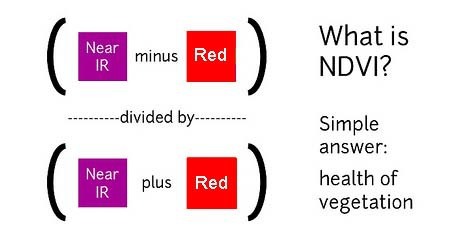](/i/44723) **NDVI = (Near Infrared - Red)/(Near Infrared + Red)** NDVI is a ratio which tries to emphasize photosynthesis while filtering out sun glare. The above equation is run for every pixel, using source data from an infrared photo and a visible light photo, like this pair: [](https://publiclab.org/system/images/photos/000/021/771/original/5390895115_c9d4d38fec_o.jpg) The result can be false-colored to make the high-photosynthesis areas more clear, and used to examine where plants are and how healthy they are. [](https://publiclab.org/system/images/photos/000/021/770/original/PetVISNDVIcomp.png) _Figure above: Normal color photo (right) and normalized difference vegetation index (NDVI) image (left). NDVI image was derived from two color channels in a single photo taken with a camera modified with a special infrared filter. Note that tree trunks, brown grass, and rocks have very low NDVI values because they are not photosynthetic. Healthy plants typically have NDVI values between 0.1 and 0.9. -- @cfastie_ ### Activities Here are a range of activities you can do to produce and interpret your own NDVI imagery, whether downloaded from a satellite imagery provider or [collected yourself using a DIY technique](/wiki/multispectral-imaging) [activities:ndvi] ****   Most DIY converted cameras today (those from Public Lab) use RGN instead of NRG, so the blue channel represents infrared instead of the red channel. That looks like this: [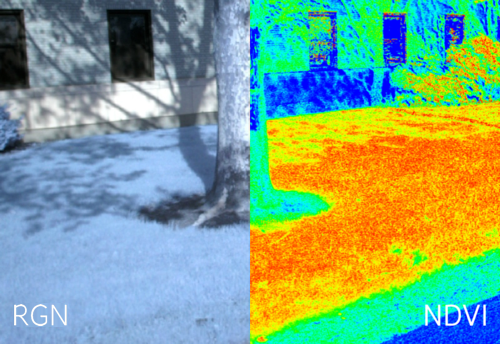](/i/45468?s=o) **** ## NRG imagery Some people are also interested in producing NRG imagery (like the below image), where `Near-Infrared, Red, and Green` are used to compose a picture instead of the usual `Red, Green, and Blue`. [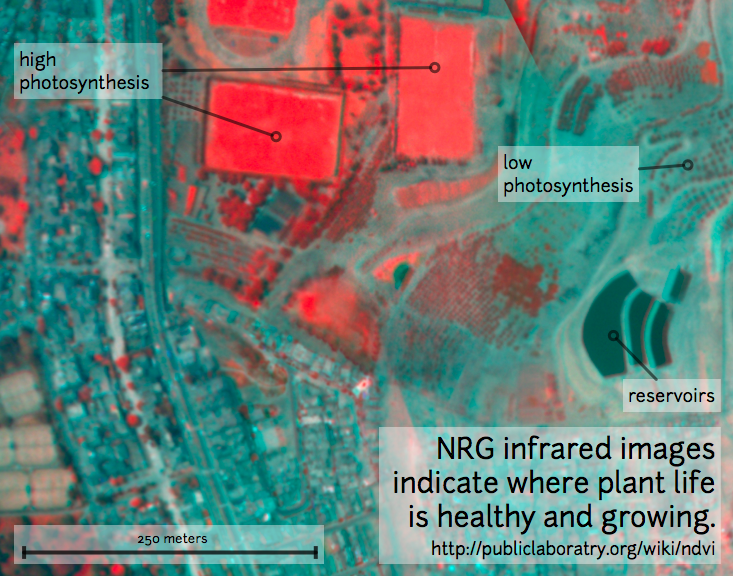](/i/25064) This diagram explains the swapping, which allows us to 'see' infrared as if it were a normal color: [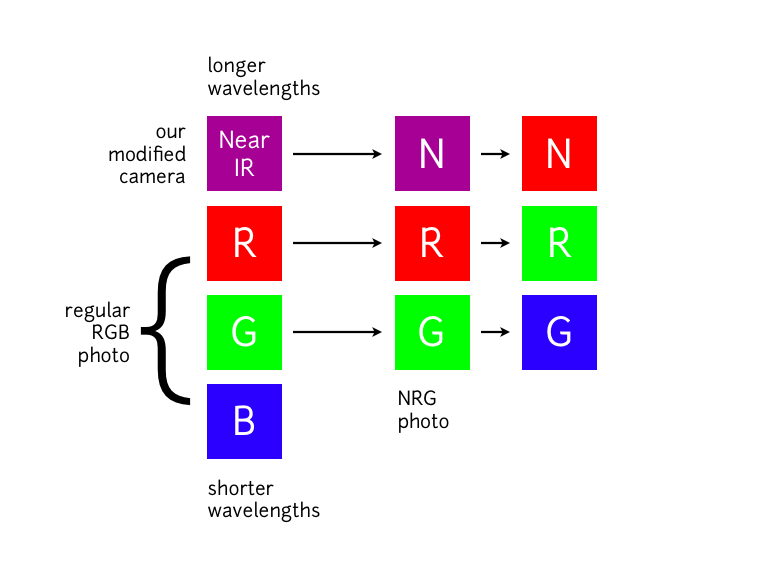](/i/25063) **In NRG images, the deeper and clearer the red color, the denser and healthier the vegetation (more or less).** ### Questions [questions:ndvi] ### Other examples of DIY NDVI imaging From around the internet: Begin watching at 2 minutes to see the resulting imagery: *This topic is part of the [Grassroots Mapping Curriculum](/wiki/mapping-curriculum) series.* **** [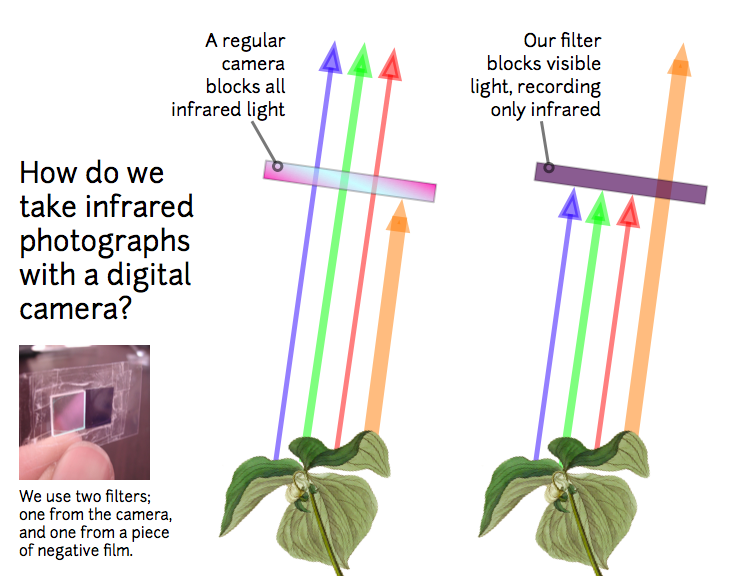](/i/25066) [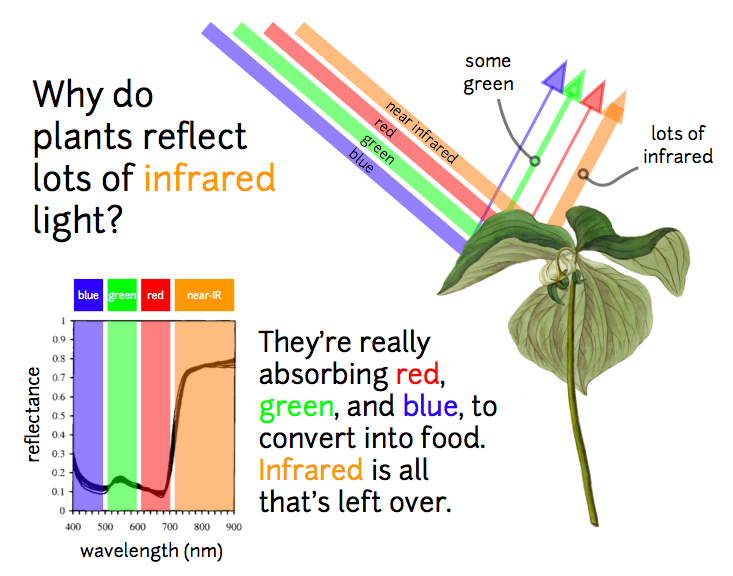](/i/25065) ...
| Author | Comment | Last activity | Moderation | ||
|---|---|---|---|---|---|
| ttaylor | "The alignment of the blue and red spectral response below 850nm that you are seeing is consistent with the spectral response curves that have been ..." | Read more » | almost 11 years ago | |||
| cfastie | "The Visible Vegetation Index (VVI) seems to do a good job distinguishing plants from non-plants based on how green each pixel is and also on some f..." | | almost 11 years ago | |||
| ecta64 | "the video link is here sorry http://publiclab.org/notes/warren/10-27-2011/video-tutorial-creating-false-color-ndvi-aerial-wetlands-imagery " | | almost 11 years ago | |||
| ecta64 | "I appreciate your comment. In making these images I first created a infrared image utilizing the tips and techniques from various forums on the Int..." | | almost 11 years ago | |||
| cfastie | "Ecta64, It looks like you were able to map green to areas in the photos with plants, so your process might have promise. If you didn't modify the ..." | | almost 11 years ago | |||
| gpenzo | "Hallo Albertazzi I bought a 30mm glass filter. Remove the housing of the filter and glue it in front of my cam. See pictures above (No idea how to ..." | Read more » | almost 11 years ago | |||
| patcoyle | "Thanks Chris. Ah, lens flare. The car is a '94 Miata - good cheap fun. " | Read more » | almost 11 years ago | |||
| Albertazzi | "Very interesting results! I have some questions, so n°1: you bought that filter online, and then simply cutted it so it fit the lens shape in the f..." | Read more » | almost 11 years ago | |||
| cfastie | "David, Did you see this note about the potential to indicate the presence of cyanobacteria using the difference between NDVI made with infrablue an..." | Read more » | almost 11 years ago | |||
| cfastie | "Great progress Pat. The Wratten 25 photos are really sharp. They should allow very good NDVI images. Also, nice car. The blemish looks a lot like..." | Read more » | almost 11 years ago | |||
| eustatic | "interested. i have a pal who works at Stennis space center looking at ocean color, and she was v interested in infragram. She will be going on a c..." | Read more » | almost 11 years ago | |||
| patcoyle | "I haven't tried to underexpose, but, in update above, did post composite showing effect of not stretching visible band and the NIR band. Doesn't ap..." | Read more » | almost 11 years ago | |||
| radialmind | "Hi, I've also recently posted a research note on NDVI and wratten25 on a cmos sensor. Eventually I got my best results by underexposing slightly an..." | Read more » | almost 11 years ago | |||
| gpenzo | "In my case I also want to capture visible images, will help the farmer to identify the problem. Can use my drone for mapping and 3d vegation maps w..." | Read more » | almost 11 years ago | |||
| cfastie | "It's good to know about the NDRE. Instead of computing the difference between reflected NIR and reflected red light, I think NDRE replaces reflecte..." | Read more » | almost 11 years ago | |||
| funkycbj | "Just so you know, 720nm is in the "red edge" region so you're not computing NDVI. You are computing the Normalized Difference Red Edge Index (NDRE). " | Read more » | almost 11 years ago | |||
| fevegal | "Nice Job. Some questions, do you have any problem with autofocus in the IR camera?. How do you do to remove IR sensor filter in A2500? " | Read more » | almost 11 years ago | |||
| cfastie | "Thanks Grayson, I was referring to stretching the histograms in the Fiji plugin. I forget what the default is, but it can make a big difference. ..." | Read more » | almost 11 years ago | |||
| gpenzo | "Hello Chris. Seems I need to be more precise on my notes, answer to your question. NIR camera has the block filter removed. 720 and 850 nm filter ..." | Read more » | almost 11 years ago | |||
| Tbtouaki | "Thanks that is exactly what I wanted to know. I am going to modify one camera, and wanted to test different filters, but was unsure if I could do ..." | Read more » | almost 11 years ago | |||
| gpenzo | "Hallo Rita. In my setup One camera is not modified. The other camera I removed the IR block filter inside. I use the 720nm or the 850nm filter on t..." | Read more » | almost 11 years ago | |||
| Tbtouaki | "Hi The first pictures I have are with only one camera and an unmodified one. Now I bought the second camera, same model as the first and was cons..." | Read more » | almost 11 years ago | |||
| cfastie | "Rita, If you are using two cameras, one unmodified and one to capture an NIR image, the best filter to use in the NIR camera is one that blocks all..." | Read more » | almost 11 years ago | |||
| Tbtouaki | "I have pictures of three different kinds: true color, 560nm IR filter, and 720nm IR filter, and I've been having the difficulty of choosing which c..." | Read more » | almost 11 years ago |